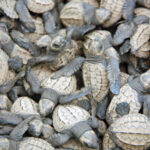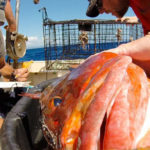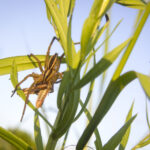
Photo from Flickr by Sergio Boscaino
She stood at the fire line, waiting. The sky blurred just above the hill, introducing the arrival of the flames. Crackling patches of yellow and red crept their way down the hill toward her. She heard an ensemble of croaking. A bunch of fast-moving black dots, soon turned into recognizable outlines. Hundreds of Pacific Chorus Frogs jumped out of the flames toward her.
Portia Halbert, a senior environmental scientist and manager of Santa Cruz state park activities, stood with her colleagues that day at Sunset State Beach in Santa Cruz, watching this rarely seen display of wildlife response to fire. They were witnessing a prescribed fire—a fire deliberately set to either rid of invasive vegetation or to serve as a fuel break to prevent future more intense fires.
Ecologists such as Halbert are increasingly using such fires to create an optimal landscape for biodiversity, but others aren’t sure that this is the best way to manage fire in California’s lands.
The California Spotted Owl—an endangered species in California—is a prime example of the ambiguity of beneficial fire practices.
California Spotted Owls face many threats, mostly because they depend on old-growth forests—those with large trees undisturbed by natural or initiated fires, logging or other practices— that are declining in great numbers. In the Sierra Nevada, old-growth forests have declined as much as 82 percent from historic numbers. The major threat to these forests is logging but fire management such as fuel breaks also plays a role.
Ecologists are trying to save the spotted owl but many disagree on whether allowing large fires to happen or controlling them through fire practices such as fuel breaks or suppression would create an optimal habitat for them.

The California spotted owl. Photo from Flickr by Julio Mulero
“We recommend that burned forest should be considered suitable foraging habitat for spotted owls,” said Monica Bond, a wildlife biologist at the Wild Nature Institute. According to her study from 2009, California spotted owls mostly roost in areas swept by low-intensity fires and forage in areas burned at high-intensity. Many ecologists believe that severe fires that burn at high-intensity can be avoided with fuel breaks using prescription fires.
“This is not surprising given the long evolutionary history spotted owls have with mixed-severity fires,” Bond said. According to Chad Hanson, co-founder of the John Muir project, historically we have had both high-intensity and low-intensity fires. Many wildlife species like the California spotted owl have adapted to this mix of different forest types.
“The underlying assumption of many fire practices is that those more intensely burned patches completely destroy wildlife habitat, but many species have evolved to depend on this snag forest habitat,” Hanson said.
Bond and her team published a study in June in the Journal of Wildlife Management that was the first to reveal foraging habitat selection of spotted owls in southern California. They found that owl territories remain occupied even after a severe fire occurs. The owl reproduction rates in the same areas pre- and post- fire did not change.
Another study published a few months later in the Frontiers in Ecology and the Environment, suggested that high-severity fires affecting large patches of land are detrimental for the California Spotted Owl. “The owl territories that experience a lot of high severity fires were very likely to become unoccupied following a fire,” said Gavin Jones, the lead author of the study.
He acknowledged the importance of low-intensity fire for these animals, but recommended some fire control to avoid these large patches of land ravaged by high-severity fires.
After looking at Bond’s study, Jones said he was left wondering what their high-severity patches looked like and how large they were. “Are these owls foraging in these large patches of intensely burned land or rather in smaller patches?” Jones said noting that even in their study they found that owls do in fact forage in smaller patches of high-intensity fire but tend to avoid the larger patches.
Although it may seem like these results show stark contrast with one another, Jones thinks that most studies may just be looking at this issue in black and white. “I think that we are all sort of talking past each other,” he said. “It’s not all about severe or not, it’s about where, to what extent, and what each high-severity patch of land looks like.” He is working to emphasize this point in the field with his next project.
“All throughout our history we have presumed to believe that we can control the landscape and oftentimes we’ve learned that we fail miserably at understanding all complexities of what we can accomplish,” Jones said. “I’m hopeful, but cautiously hopeful. We can wipe species out by doing the wrong thing.”
This kind of ambiguity in fire practice decisions is not limited to this discussion about optimal habitat for spotted owls. It continues on to discussions about which fire practices would best create natural conditions? Do we suppress some fire or let them take over large portions of the landscape? Every decision marks a change in the landscape and paints a picture for the animals that live there.
If we make the correct decisions, Jones added, “Who knows, maybe the spotted owl will outlive us all.”







Comments are closed.